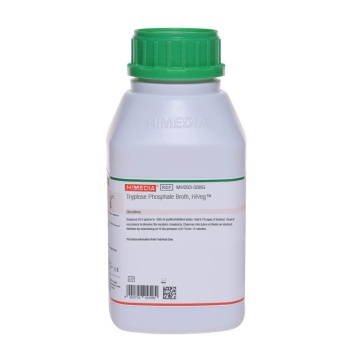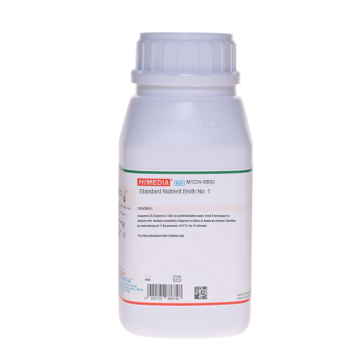 Your enquiry has been submitted
Your enquiry has been submitted
Tryptose Phosphate Broth
Intended use
Used for cultivation of fastidious bacteria from clinical and non-clinical samples.
Composition**
| Ingredients | g/L |
|---|---|
| Tryptose | 20.000 |
| Dextrose | 2.000 |
| Sodium chloride | 5.000 |
| Disodium phosphate | 2.500 |
Final pH (at 25°C): 7.3±0.2
**Formula adjusted, standardized to suit performance parameters
Directions
Suspend 29.5 grams in 1000 ml purified / distilled water. Add 0.1% agar, if desired. Heat if necessary to dissolve the medium completely. Dispense in tubes or flasks as desired. Sterilize by autoclaving at 15 lbs pressure (121°C) for 15 minutes.
Principle And Interpretation
Tryptose Phosphate Broth is prepared as recommended by APHA (1) for the cultivation of fastidious aerobic bacteria especially Streptococcus species, Listeria and pathogenic Neisseria species. It is also used for antibiotic sensitivity testing by tube method (2). This medium with the addition of agar and sodium azide is used for the isolation of pathogenic Streptococci, Neisseria and other fastidious microorganisms from dairy products (3) and clinical specimens. Tryptose Phosphate Broth with added agar can also be used for emulsification of cheese before isolation of Brucella species (1) and is also recommended by Diagnostic Procedures and Reagents (4).
The inclusion of tryptose as nitrogen sources makes this medium highly nutritious. Dextrose serves as the source of fermentable carbohydrate. Sodium chloride maintains osmotic equilibrium. Phosphate salt helps in buffering the medium. The addition of 0.1-0.2% agar to M093 facilitates anaerobic growth and aids in dispersion of reducing substances and carbon dioxide formed in the environment (2).
For blood culture work aseptically add 10 ml of sterile defibrinated blood to 150 ml of sterile medium in 300 ml Erlenmeyer flask. Incubate and subculture on other media.
Type of specimen
Clinical samples - Urine; Food and dairy samples
Specimen Collection and Handling:
For clinical samples follow appropriate techniques for handling specimens as per established guidelines (5,6).
For food and dairy samples, follow appropriate techniques for sample collection and processing as per guidelines (1,3,4).
After use, contaminated materials must be sterilized by autoclaving before discarding.
Warning and Precautions :
In Vitro diagnostic Use. For professional use only. Read the label before opening the container. Wear protective gloves/protective clothing/eye protection/ face protection. Follow good microbiological lab practices while handling specimens and culture. Standard precautions as per established guidelines should be followed while handling clinical specimens. Safety guidelines may be referred in individual safety data sheets.
Limitations :
- Individual organisms differ in their growth requirement and may show variable growth patterns on the medium.
- Each lot of the medium has been tested for the organisms specified on the COA. It is recommended to users to validate the medium for any specific microorganism other than mentioned in the COA based on the user's unique requirement.
Performance and Evaluation
Performance of the medium is expected when used as per the direction on the label within the expiry period when stored at recommended temperature.
Quality Control
Appearance Cream to yellow homogeneous free flowing powder
Colour and Clarity of prepared medium Yellow coloured clear solution without any precipitate.
Reaction Reaction of 2.95% w/v aqueous solution at 25°C. pH: 7.3±0.2
pH 7.10-7.50
Cultural Response
Cultural characteristics observed after an incubation at 35-37°C for 18-24 hours.
| Organism | Inoculum (CFU) | Growth |
|---|---|---|
| Neisseria meningitidis ATCC 13090 | 50-100 | good-luxuriant |
| Staphylococcus aureus subsp. aureus ATCC 25923 (00034*) | 50-100 | good-luxuriant |
| Streptococcus pneumoniae ATCC 6303 | 50-100 | good-luxuriant |
| Streptococcus pyogenes ATCC 19615 | 50-100 | good-luxuriant |
| Staphylococcus epidermidis ATCC 12228 (00036*) | 50-100 | good-luxuriant |
Key: (*) Corresponding WDCM numbers.
Storage and Shelf Life
Store between 10-30°C in a tightly closed container and the prepared medium at 15-30°C. Use before expiry date on the label. On opening, product should be properly stored dry, after tightly capping the bottle in order to prevent lump formation due to the hygroscopic nature of the product. Improper storage of the product may lead to lump formation. Store in dry ventilated area protected from extremes of temperature and sources of ignition Seal the container tightly after use. Product performance is best if used within stated expiry period.
Disposal
User must ensure safe disposal by autoclaving and/or incineration of used or unusable preparations of this product. Follow established laboratory procedures in disposing of infectious materials and material that comes into contact with clinical sample must be decontaminated and disposed of in accordance with current laboratory techniques (3,4).
Reference
- American Public Health Association, Standard Methods for the Examination of Dairy Products, 1978, 14th Ed., Washington D.C.
- American Public Health Association, 1953, Diagnostic Procedures and Reagents, 4th ed., APHA Inc., New York.
- Isenberg, H.D. Clinical Microbiology Procedures Handbook. 2nd Edition.
- Jorgensen, J.H., Pfaller, M.A., Carroll, K.C., Funke, G., Landry, M.L., Richter, S.S and Warnock., D.W. (2015) Manual of Clinical Microbiology, 11th Edition. Vol. 1.
- MacFaddin J., 1985, Media for Isolation-Cultivation-Identification-Maintenance of Medical Bacteria, Vol. I, Williams and Wilkins, Baltimore.
- Newman R.W., 1950, J. Milk Food, Tech., 13 : 226.
| Product Name | Tryptose Phosphate Broth |
|---|---|
| SKU | M093 |
| Product Type | Regular |
| Physical Form | Powder |
| Origin | Animal |
| Packaging type | HDPE |
| References | 1.American Public Health Association , 1976, Standard Methods for the Examination of Dairy Products, 14th ed., APHA Inc.,New York. 2.MacFaddin J., 1985, Media for Isolation-Cultivation-Identification-Maintenance of Medical Bacteria, Vol. I, Williams andWilkins, Baltimore. 3.American Public Health Association, 1953, Diagnostic Procedures and Reagents, 4th ed., APHA Inc., New York. 4.Newman R.W., 1950, J. Milk Food, Tech., 13 : 226. 5.American Public Health Association, 1953, Standard Methods for the Examination of Dairy Products, 10th ed., APHA Inc.,New York. |
| Customized Product Available | No |










